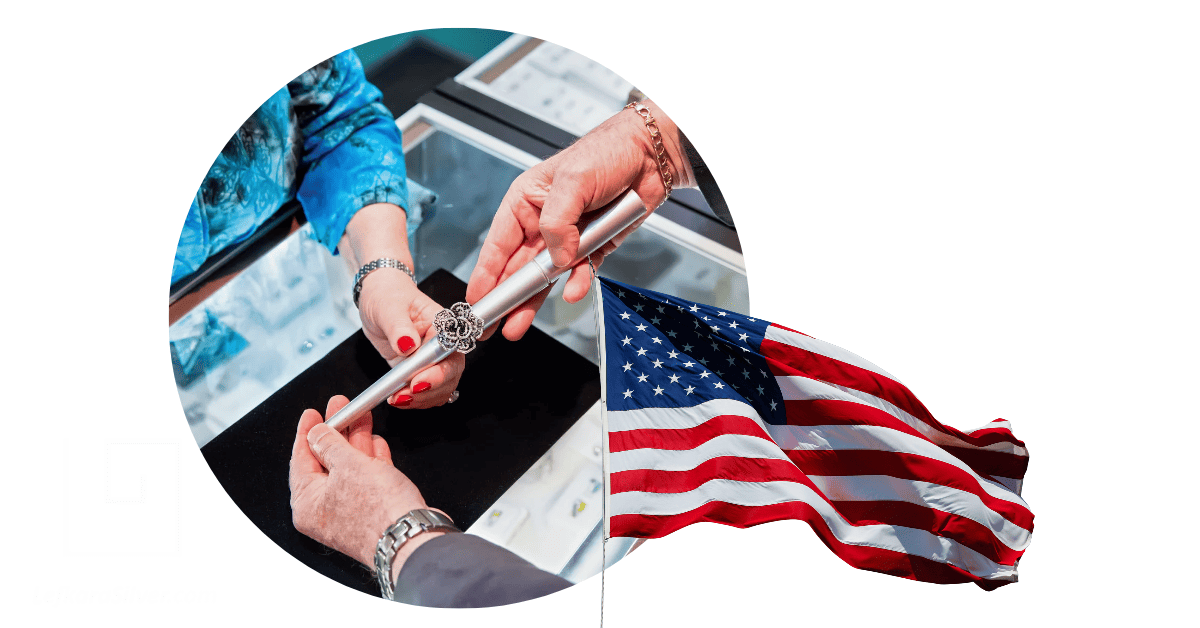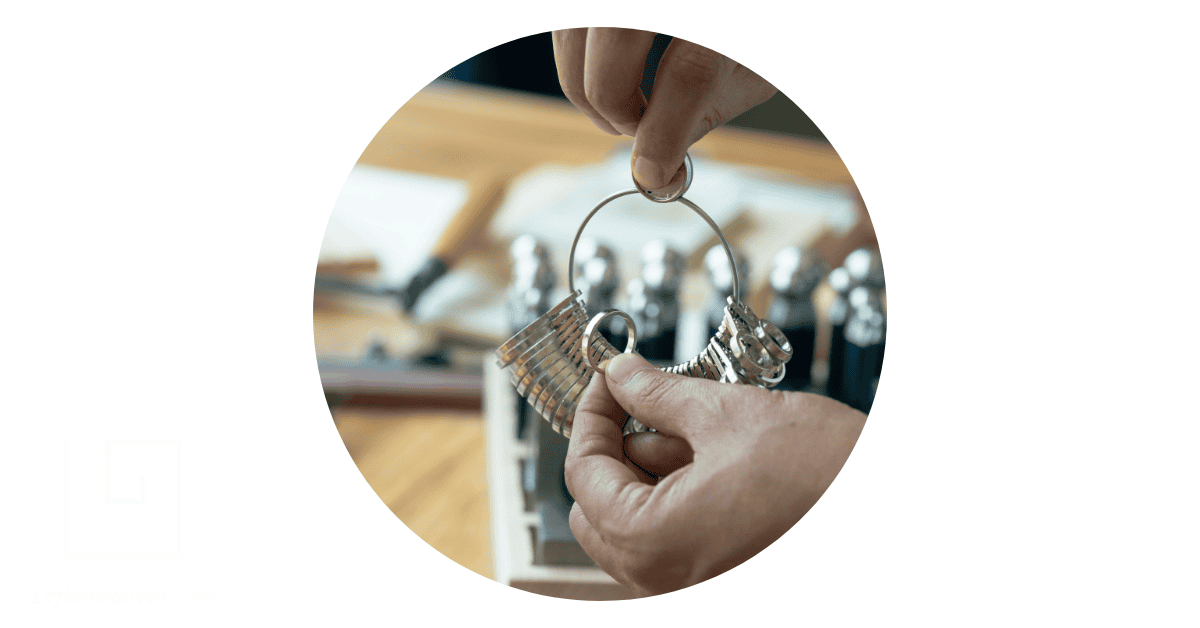
US Ring Size Conversion Calculator & Table – 2025 (US, UK, EU)
Nailing the correct ring size is an essential part of any jewelry purchase. An improper fit can lead to the constant worry of a ring slipping off or the discomfort of a band that’s too constricting.
On this page, you will find our free US ring size conversion calculator to help you convert your US ring size to all other international ring size regions. This will help you choose the correct ring size from any online jewelry store, without any worries.
US Ring Size Conversion Calculator
To use the US Ring Size Conversion Calculator, simply select your US ring size from the dropdown bar below, and see the equivalent units for Europe, the US, and Asia, among other regions.
International Ring Size Converter
Equivalent Sizes:
- UK & Australia: –
- EU (Circumference): –
- Japan, China & S. America:
- Switzerland: –
*Values marked with an asterisk are approximated as a direct, standardized equivalent is not available. Values marked as <0* are smaller than the official starting point of the Swiss sizing system.
If you know your ring size in a different format, you can use our other dedicated conversion tools. We have calculators based on the UK (Letter), EU (Circumference), Japanese, and Swiss standards.
Once you have found your perfect size, we invite you to view our list of handmade silver filigree rings and silver opal rings.
US Ring Size Conversion Table
| US & Canada | UK & Australia | EU (Circumference in mm) | Japan, China & S. America | Switzerland |
| 0.5 | A | 37.5 | 0.5* | <0* |
| 0.75 | A ½ | 38.2 | 0.8* | <0* |
| 1 | B | 38.9 | 1 | <0* |
| 1.25 | B ½ | 39.5 | 1.5* | <0* |
| 1.5 | C | 40.2 | 2 | 0.2 |
| 1.75 | C ½ | 40.8 | 2.5* | 0.8 |
| 2 | D | 41.5 | 3 | 1.5 |
| 2.25 | D ½ | 42.1 | 3.5* | 2.1 |
| 2.5 | E | 42.8 | 4 | 2.8 |
| 2.75 | E ½ | 43.4 | 4.5* | 3.4 |
| 3 | F | 44.1 | 5 | 4.1 |
| 3.25 | F ½ | 44.7 | 5.5* | 4.7 |
| 3.5 | G | 45.4 | 6 | 5.4 |
| 3.75 | G ½ | 46.0 | 7 | 6.0 |
| 4 | H | 46.7 | 8 | 6.7 |
| 4.25 | H ½ | 47.3 | 8.5* | 7.3 |
| 4.5 | I | 48.0 | 9 | 8.0 |
| 4.75 | I ½ | 48.6 | 9.5* | 8.6 |
| 5 | J | 49.2 | 10 | 9.2 |
| 5.25 | J ½ | 49.9 | 10.5* | 9.9 |
| 5.5 | K | 50.5 | 11 | 10.5 |
| 5.75 | K ½ | 51.2 | 11.5* | 11.2 |
| 6 | L | 51.8 | 12 | 11.8 |
| 6.25 | L ½ | 52.5 | 12.5* | 12.5 |
| 6.5 | M | 53.1 | 13 | 13.1 |
| 6.75 | M ½ | 53.8 | 13.5* | 13.8 |
| 7 | N | 54.4 | 14 | 14.4 |
| 7.25 | N ½ | 55.1 | 14.5* | 15.1 |
| 7.5 | O | 55.7 | 15 | 15.7 |
| 7.75 | O ½ | 56.4 | 15.5* | 16.4 |
| 8 | P | 57.0 | 16 | 17.0 |
| 8.25 | P ½ | 57.6 | 16.5* | 17.6 |
| 8.5 | Q | 58.3 | 17 | 18.3 |
| 8.75 | Q ½ | 58.9 | 17.5* | 18.9 |
| 9 | R | 59.6 | 18 | 19.6 |
| 9.25 | R ½ | 60.2 | 18.5* | 20.2 |
| 9.5 | S | 60.9 | 19 | 20.9 |
| 9.75 | S ½ | 61.5 | 19.5* | 21.5 |
| 10 | T | 62.2 | 20 | 22.2 |
| 10.25 | T ½ | 62.8 | 21 | 22.8 |
| 10.5 | U | 63.5 | 22 | 23.5 |
| 10.75 | U ½ | 64.1 | 22.5* | 24.1 |
| 11 | V | 64.7 | 23 | 24.7 |
| 11.25 | V ½ | 65.4 | 23.5* | 25.4 |
| 11.5 | W | 66.0 | 24 | 26.0 |
| 11.75 | W ½ | 66.7 | 24.5* | 26.7 |
| 12 | X | 67.3 | 25 | 27.3 |
| 12.25 | X ½ | 68.0 | 25.5* | 28.0 |
| 12.5 | Y | 68.6 | 26 | 28.6 |
| 12.75 | Y ½ | 69.2 | 26.5* | 29.2 |
| 13 | Z | 69.9 | 27 | 29.9 |
| 13.25 | Z ½ | 70.5 | 27.5* | 30.5 |
| 13.5 | Z+1 | 71.2 | 28 | 31.2 |
| 14 | Z+2 | 72.5 | 29* | 32.5 |
| 14.5 | Z+3 | 73.7 | 30* | 33.7 |
| 15 | Z+4 | 74.8 | 31* | 34.8 |
| 15.5 | Z+5 | 76.0 | 32* | 36.0 |
| 16 | Z+6 | 76.9 | 33* | 36.9 |
Disclaimer: Values marked with an asterisk (*) are approximated as a direct, standardized equivalent is not available. Values marked as <0* are for sizes that are smaller than the official starting point of the Swiss sizing system and are mathematical extrapolations. These units were measured based on international ring size standards.
Pro Tips for an Accurate US Ring Size Conversion Measurement

Getting your ring size right is all about precision and avoiding common mistakes. For a measurement you can trust, especially when shopping online, follow these professional tips to eliminate the guesswork and find your perfect, comfortable fit.
- Go to a Professional for the Gold Standard: The most reliable way to get your ring size is to visit a local jeweler. They have the right tools and experience, and this service is almost always free. This is the best option before making a significant purchase.
- Use a Reusable Sizer for At-Home Accuracy: If you can’t get to a jeweler, the next best thing is a plastic ring sizer. These inexpensive tools function like a small belt for your finger, offering far more accuracy than DIY methods, and can be reused for future purchases.
- Measure 3-4 Times for a Reliable Average: Your finger size fluctuates throughout the day due to temperature and hydration. To find the most accurate size, measure your finger a few times—morning, afternoon, and evening—and average the results.
- Avoid Using String or Floss: Never use a piece of string, dental floss, or any other stretchy material to measure your finger. These can stretch or compress as you wrap them, leading to a highly inaccurate measurement and a poorly fitting ring.
- Use Paper Correctly (If You Must): If you’re using a DIY method, choose a strip of non-stretchy paper. Wrap it snugly around the base of your finger, mark where the end overlaps, and then measure that length with a ruler.
- Consider the Band Width: A wide band (typically 6mm or more) will fit more snugly than a thin band of the same size. As a rule, you should go up a quarter or half size for wider rings.
- Measure the Correct Finger and Hand: Note that your fingers are not the same size on both hands. Your dominant hand is often up to half a size larger, so be sure to measure the exact finger you plan to wear the ring on.
- When in Doubt, Size Up: If your measurement falls between two sizes, it’s generally safer to choose the larger size. It is much easier and less risky for a jeweler to make a ring slightly smaller than it is to make it bigger.
Putting It All Together: Sizing with Confidence
You are now in complete control of finding your perfect ring size. By understanding that your ring size is not a static number but a variable measurement—influenced by factors from the time of day to the ring’s design—you’ve traded guesswork for certainty. This knowledge is your single most effective tool for guaranteeing a comfortable and secure fit, giving you total peace of mind.
Achieving this level of accuracy with this US ring size conversion calculator is particularly vital when it comes to intricate filigree rings, as any attempt to resize them is a risky proposition that can compromise the piece’s artistry. The worry of receiving a ring that’s too tight or dangerously loose is gone, allowing you to focus on the fascinating part: finding that perfect filigree ring that seems destined for your hand.
